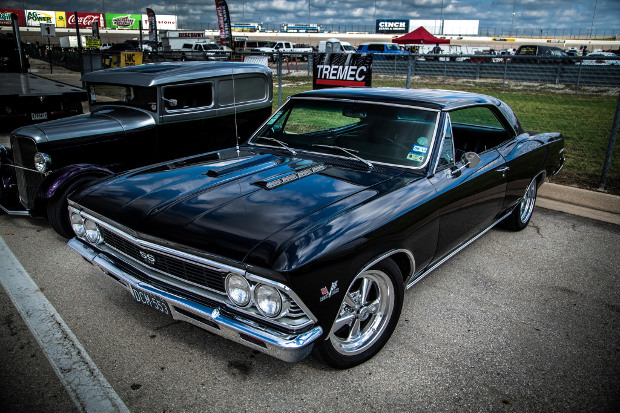Has the Modern Car Lost Its Voice? The Rise of Fake Engine Noise
There is something undeniably powerful in the deep, throaty purr of a Chevelle SS motor. It’s like music to a classic car lover’s ears, and that song has become the trademark for a variety of makes and models over the years.

One mean looking Chevelle SS. Image courtesy HHClassic.com.
At one time, the distinctive growl of a finely-tuned motor was reserved for high profile and higher income consumers who were able to most comfortably afford the cost and maintenance of such a vehicle. But times have changed. Advances in supercharger and turbocharger technologies, improvements in the design of mufflers, and the advent of the electric hybrid have contributed, in part, to quieting the roadways. Superior insulation in car cabins with dynamic acoustics has also contributed to eliminating undesirable motor noise. Government noise standard regulations and an increasing interest in reducing carbon footprints and dependency on fossil fuels has helped to push forward the initiatives of green powered cars.
In some circles, these developments have led the whisper-quiet engine to become far more desirable, being viewed as a sign of progress and quality. But not everyone has been pleased with the change. Read more
The Muscle Hustle – The REAL Story Of The First Muscle Car Isn’t So Simple
In 1964, Pontiac invented an entirely new market, for a class of cars that had never been seen before, with the introduction of the GTO. At least, that’s how the story is supposed to go. Anytime you sit down and start looking at online used cars, the one thing you are guaranteed to see on every listing of the GTO is that it is the “first muscle car”.

1964 Pontiac GTO / Image credit
So, what is a muscle car, anyway? The Merriam-Webster Dictionary defines it as “…American-made 2-door sports coupes with powerful engines designed for high-performance…” However, who put them in charge? Why does a car have to be a 2-door to qualify? What is the reason it needs to be a sports coupe? A GTO isn’t a sports coupe, for instance. It’s a hardtop coupe with nothing to set it apart from a sedan except that it doesn’t have side pillars.
For the generation that was actually around in the 1960s and 1970s when these cars were burning asphalt and rubber, the definition of a muscle car is entirely different than what you see today. Read more
Custom Big Rigs: Aftermarket Exhaust in the Commercial Driving World
In the commercial driving industry, fuel-economy and exhaust issues are increasingly consequential, especially as gas prices remain high and emission restrictions tighten. The benefits of upgrading a big rig’s exhaust system, therefore, become increasingly attractive. Though the inspiration for integrating better-performing exhaust parts into big rigs is often more oriented toward reducing the environmental impact of fuel consumption and emissions than the average consumer who is interested in beefing up their ride, the focus on these issues means that the commercial driving industry is in a position to lead the way in improving exhaust technology.

Intel custom shipping trucks used for trade shows and conventions
A Guide to Modern Italian Sports Cars
If you find yourself wondering about the history of Italian supercar manufacturers – or just want to learn a little more about your favorite brand – check out the guide below. Read more
Australia’s Fastest Production Cars That Won’t Break The Bank
There are several fast and sporty production vehicles available to Australians for under $40,000. Many feature powerful turbo engines and great standard features for their class. There are offerings from Germany, France and Italy in the lineup. You won’t confuse any of the cars on this list with a Toyota Corolla!
The Peugeot 308 Allure

Peugeot 308 Allure
French carmaker Peugeot offers the feisty 2012 308 Allure with its 2.0 liter six speed turbo-diesel engine and 120kW (161hp)and 340Nm (250 lb-ft) torque. Standard features include items that are included on prestige cars like Read more
Three Great Reasons To Upgrade Your Vehicle Exhaust System
If you’ve ever wondered why someone would remove a perfectly good factory-spec exhaust system and replace it with a loud after-market exhaust system, I’ve got three great reasons for you: Read more
A Near Death Experience: 360 Rollover
Before the car accident that almost killed me, I used to love taking long distance road trips across the country. I still enjoy traveling, but I will never again be able to drive down the highway without remembering how I almost died in a vehicle rollover accident.

A rollover that changed one person’s life – read the story below.
Hot Pipes and Pin Stripes
I purchased my first car at the age of 16 on a cold day in January. She was a 1969 Ford Mustang Coupe, which I managed to pick up in an estate auction for just under $2,000, and she is still my daily driver to this very day. Before the purchase, the process of searching for this my first car lasted nearly a year, during which time my father taught me the ins and outs of shopping used.

Exhaust makes all the difference – A fast-sounding and great-looking Mustang with an original straight six.
I checked out many makes and models of cars, test-driving each to get a feel, and it was not long before I realized the car would have to be a classic or nothing. Though I was not sure at the time what I would end up with, there was one requirement that I had to adhere to by order of my parents: no V8s. Insurance costs, safety, and the fact that my parents actually knew what I was capable of were all reasons for this decision on their end. Read more
Top 3 Performance Exhaust System Brands

Choosing the right exhaust system brand doesn't have to be difficult
So, you’re finally ready to drop an aftermarket performance exhaust system in your car, excellent! But, where do you start looking and what brands have proven themselves to be worth every penny? There’s nothing like adding a modification to your precious baby and loving every minute of its performance for the next several years. There is also nothing worse than making a modification to your car and it not working or falling apart over time. Nothing worse at all. Here are a few things to keep in mind when you’re in the market for a new performance exhaust system. Let’s start with reputations first. Read more
The Evolution of Suspension Systems

There are a lot of differences between race cars and consumer sports cars, and the suspension system is probably the biggest.
Many parts elevate a racing car above a consumer sports car, but not all of those parts reside in the engine compartment.As a matter of fact, the biggest differences between your run-of-the-mill race car and your run-of-the-mill consumer sports car are:
- Race cars don’t have sound deadening materials anywhere, so they’re loud as hell
- Race cars don’t have any creature comforts like leather upholstered seats, air conditioning, 8 speaker surround-sound s tereos, etc. Just a hard, uncomfortable seat, a steering wheel, a racing harness, and a couple of pedals. The fire extinguisher is the only “extra.”
- Race cars have aggressive, tight suspension systems that ride rougher than a milk wagon. Of course, they also allow for unparalleled handling
What follows is a quick little primer on suspension systems – great background info for any auto enthusiast. Read more








